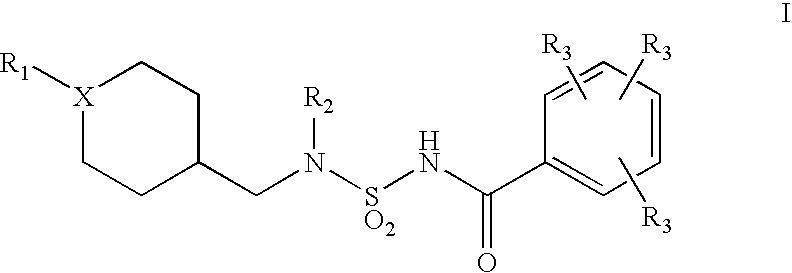Acyl sulfamides for treatment of obesity, diabetes and lipid disorders
a technology of acyl sulfamide and lipid disorder, applied in the field of acyl sulfamide for the treatment of obesity, diabetes and lipid disorders, can solve the problems of obesity, obesity, widespread medical problems, etc., and achieve the effect of effective treatment, control and/or prevention
- Summary
- Abstract
- Description
- Claims
- Application Information
AI Technical Summary
Benefits of technology
Problems solved by technology
Method used
Image
Examples
example 1
N-benzyl-N-{[4-({[tert-butyl(dimethyl)silyl]oxy}methyl)cyclohexyl]methyl}amine (1): {4-[(benzylamino)methyl]cyclohexyl}methanol (CAS 46843-17-8) (594 mg, 2.55 mmole, 1.0 eq) was dissolved in 2 mL of N,N-dimethylfornamide, then treated with imidazole (434 mg, 6.1 mmole, 2.5 eq) and dimethyl-tert-butylsilyl chloride (461 mg, 3.06 mmole, 1.2 eq). The solution was stirred for 18 hours, then it was diluted with dichloromethane and washed 3× with water. The organic was dried over potassium carbonate, filtered and evaporated. The crude isolate was purified by silica gel chromatography to give the TBS protected alcohol (1) in quantitative yield. Mass spectrum (ES+), calculated M+347.26, observed (M+1) 348.3.
N-benzyl-N-{[4-({[tert -butyl(dimethyl)silyl]oxy}methyl)cyclohexyl]methyl}sulfamide (2): (1)(880 mg, 2.53 mmole, 1.0 eq) was dissolved in 20 mL of 1,2-dimethoxyethane. Sulfamide (1.22 grams, 12.66 mmole, 5.0 eq) was added and the reaction was stirred at reflux overnight. Monitoring by T...
example 2
(4-{[benzyl({[3,5-bis(trifluoromethyl)benzoyl]amino}sulfonyl)amino]methyl}cyclohexyl)methyl pentanoate (6): Following procedure to make (5), valeryl chloride was substituted for benzoyl chloride to give the title compound after purification. 1H NMR (500 MHz, DMSO-d6): δ 8.45 (s, 2H), 8.14 (s, 1H), 7.36 (d, 2H), 7.25 (t, 2H), 7.17 (t, 1H), 4.38 (s, 2H), 3.70 (d, 2H), 3.30 (water), 2.917 (d, 2H), 2.48 (DMSO), 2.22 (t, 2H), 1.62 (m, 2H), 1.52 (m, 2H), 1.45 (m, 2H), 1.37 (m, 1H), 1.26 (m, 1H), 1.22 (m, 2H), 0.82 (t, 3H), 0.63 (m, 4H).
example 3
(4-{[benzyl({[3,5-bis(trifluoromethyl)benzoyl]amino}sulfonyl)amino]methyl}cyclohexyl)methyl phenylcarbamate (7): Intermediate (4) (80 mg, 140 μmole, 1.0 eq) was dissolved in acetonitrile (10 mL) and phenyl isocyanate (18 μL, 168 μmole, 1.2 eq) was added. The mixture was refluxed for 24 hours, then diluted with water and extracted repeatedly with dichloromethane. Reconstituted in dichloromethane, filtered off precipitate and purified material isolated from filtrate by RP-HPLC to give title compound. 1H NMR (400 MHz, MeOH-d4): δ 0-75-9.0 (m, 4H), 1.38-1.60 (m, 2H), 1.68-1.84 (m, 4H), 3.21 (d, 2H, J=8 Hz), 3.86 (d, 2H, J=8 Hz), 4.51 (s, 2H), 7.0 (t, 1H, J=8 Hz) 7.17-7.30 (mult, 5H), 7.33-7.7.45 (mult, 4H), 8.11 (s, 1H), 8.42 (s, 2H).
PUM
 Login to View More
Login to View More Abstract
Description
Claims
Application Information
 Login to View More
Login to View More - R&D
- Intellectual Property
- Life Sciences
- Materials
- Tech Scout
- Unparalleled Data Quality
- Higher Quality Content
- 60% Fewer Hallucinations
Browse by: Latest US Patents, China's latest patents, Technical Efficacy Thesaurus, Application Domain, Technology Topic, Popular Technical Reports.
© 2025 PatSnap. All rights reserved.Legal|Privacy policy|Modern Slavery Act Transparency Statement|Sitemap|About US| Contact US: help@patsnap.com



